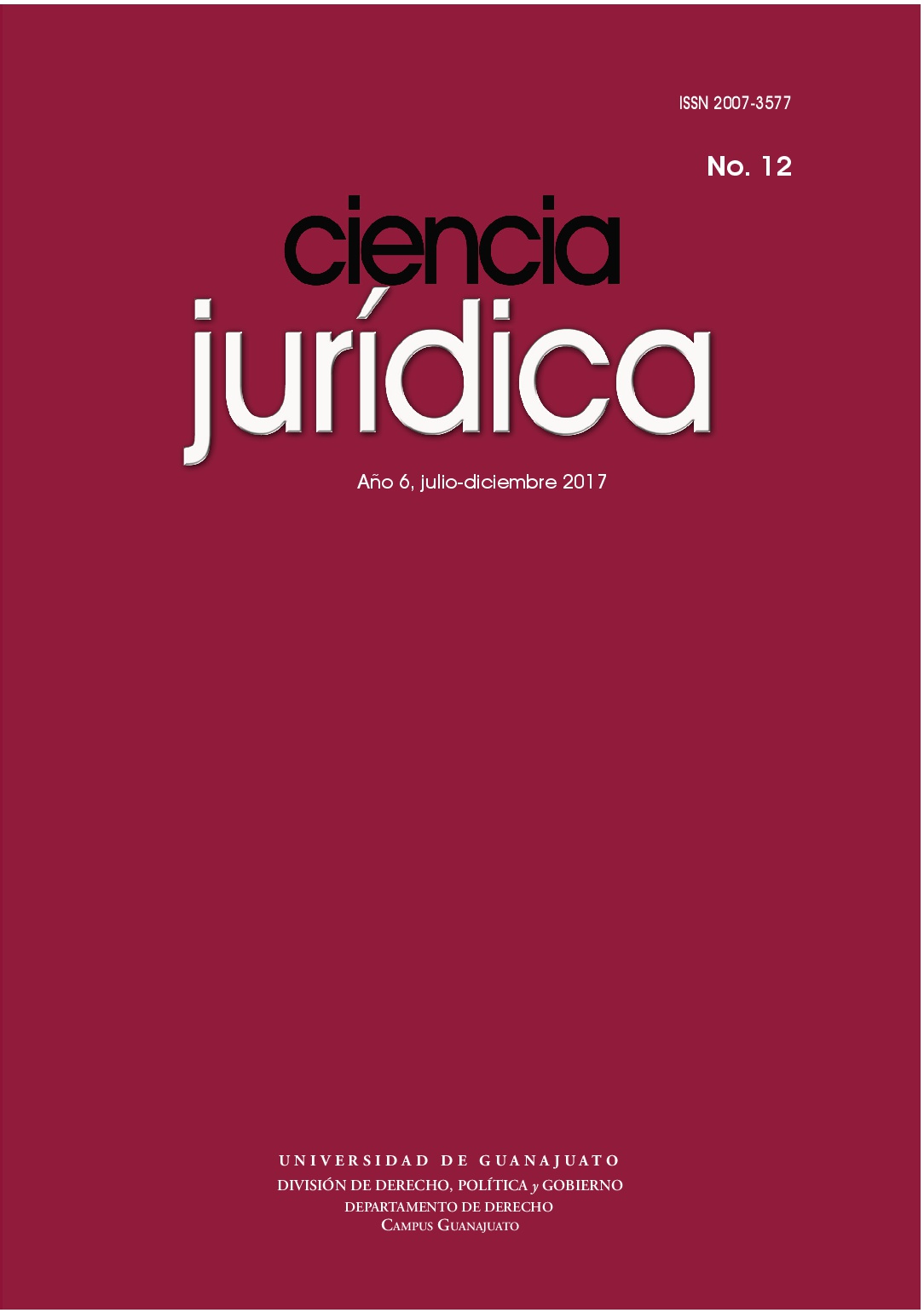Abstract
The rational use of pretrial detention constitutes one of the main goals of the new criminal justice system, which seeks to modify the systematic abuse of it, to that extent the criterion of the danger of the defendant being subtracted from the process and its legal guidelines, contribute to this purpose as an evaluation tool. The juridical interpretation of this criterion and its legal guidelines has been made by the legal operator, is not peaceful, its legal indetermination has generated clashes and found criteria, reason why it is sought to clarify the meaning of these guidelines, in order to promote the uniformity or predictability of interpretive meanings and criteria, which are an essential element for legal certainty in a democratic and legal State. With this aim the legal guidelines are developed, from the theoretical point of view, task for which it was necessary previously the general and synthetic pronouncement on the legal nature of the preventive prison, the purposes of the same, as well as the principles of presumption of innocence, proportionality and minimumintervention, all of which constitute as essential guidelines, which allow to give meaningful content to that criterion and its legal guidelines, and in turn limit the activity of the legal operator, in order to unrestricted respect for individual freedom.
References
ATIENZA, Manuel (2005), Diez consejos para escribir un buen trabajo de dogmática, Revis-ta de Teoría y Filosofía del Derecho, Núm.3 octubre, pp. 223-224 http://www.cervantesvirtual.com/obra/diez-consejos-para-escribir-un-buen-trabajo-de-dogmtica-0/.
BARATTA, Alessandro (2004), Criminología y Sistema Penal (Compilación in memoriam), Editorial B de F, Buenos Aires, Argentina.
BOTERO C., Martín Eduardo (2008), El sistema procesal penal acusatorio. El justo proceso. Funcionamiento y Estructura Prospectiva de Italia para América Latina, Ediciones Jurídicas Andrés Morales, Bogotá, Colombia.
CHACÓN ROJAS, Oswaldo (2011), Las Medidas Cautelares en el Procedimiento Penal Acu-satorio, Secretaría Técnica del Consejo de Coordinación para la Implementación del Sistema de Justicia Penal, Gobierno Federal, SEGOB, México.
Consecuencias Colaterales: porqué la prisión preventiva obstaculiza el desarrollo socioeco-nímico, Campaña Global para la Justicia Previa al Juicio, Open Society Foundations, Open Society Justice Initiative, [en línea], disponible en: http://redjusticiaprevia.com/wp-content/uploads/2015/01/Spanish-PTD-socioec-summary.doc.pdf.
CONSTANTINO RIVERA, Camilo (2011), Introducción al Estudio Sistemático del Proceso Penal Acusatorio (Juicios Orales), quinta edición.
DALL” ANESSE, Francisco (2000), El proceso penal juvenil Costarricense: principios y al-ternativas a la justicia, en Gonzalo O., en González Oviedo, Mauricio y Tiffer So-tomayor, Carlos (coord.) De la arbitrariedad a la Justicia: Adolescentes y Responsa-bilidad Penal en Costa Rica, 1ª. Ed., UNICEF, Costa Rica.
DE LA CORTINA, José Miguel (2015), Las medidas cautelares personales en el proceso pe-nal, Bosch, España.
DEL RÍO LABARTHE, Gonzalo (2009), La prisión preventiva en la jurisprudencia del Tribu-nal Constitucional, en García Cavero, Percy (Coord.) Temas Penales en la Jurispru-dencia del Tribunal Constitucional. Anuario de Derecho Penal 2008, Universidad de Friburgo Suiza, Fondo Editorial de la Pontificia Universidad Católica del Perú, Perú.
EMBRIS VÁSQUEZ, José Luis (2013), Medidas cautelares su transición al sistema acusatorio, adversarial y oral en México, segunda edición, Editorial Porrúa, México.
GARCÌA PÉREZ, Octavio, La racionalidad de la proporcionalidad en sistemas orientados a la prevención especial, Revista Electrónica de Ciencia Penal y Criminológica ISSN1695-0194, http://criminet.ugr.es/recpc/09/recpc09-09.pdf.
GÓMEZ PÉREZ, Mara (2014), “La jurisprudencia interamericana sobre prisión preventiva”, en García Ramírez, Sergio et. al. (coord.), Criterios y jurisprudencia interamericana de derechos humanos: influencia y repercusión en la justicia penal, Instituto de In-vestigaciones Jurídicas, Universidad Autónoma de México, México, [en línea], dis-ponible en: https://biblio.juridicas.unam.mx/bjv/detalle-libro/3817-criterios-y-jurisprudencia-interamericana-de-derechos-humanos-influencia-y-repercusion-en-la-justicia-penal.
HASSEMER, Winfried (1998), “Los presupuestos de la prisión preventiva”, en Crítica al De-recho penal de hoy (trad. de Patricia S. Ziffer), Universidad Externado de Colom-bia, Bogotá.
Informe sobre el Uso de la Prisión Preventiva en las Américas, Organización de los Estados Américanos, Comisión Interamericana de Derechos Humanos, Gobierno de España, Ministerio de Asuntos Exteriores y de cooperación, [en línea], disponible en: http://www.oas.org/es/cidh/ppl/informes/pdfs/informe-pp-2013-es.pdf.
LLOBET RODRÍGUEZ, Javier (2010), La prisión preventiva (Límites Constitucionales), 3ra. Edición, Editorial Jurídica Continental (EJC), San José, Costa Rica.
_______ (2014), Proceso Penal Comentado (Código Procesal Penal Comentado), 5ta edi-ción, Editorial Dominza, Editorial Jurídica Continental, Costa Rica.
MAIER, Julio B. (1989), Derecho Procesal Penal argentino. Vol. 2. Hammurabi, Buenos Aires.
MARTOS NÚÑEZ, Juan Antonio (1987), “El principio de intervención penal mínima”, en: Anuario de Derecho Penal y Ciencias Penales, España, [en línea], disponible en: https://www.boe.es/publicaciones/anuarios_derecho/abrir_pdf.php?id=ANU-P-1987-10009900134.
PÉREZ LÓPEZ, Jorge A., El peligro procesal como presupuesto de la medida coercitiva per-sonal de prisión preventiva. Revista Derecho y Cambio Social, fi-le:///C:/Users/PROBOOK/Downloads/Dialnet-ElPeligroProcesalComoPresupuestoDeLaMedidaCoerciti-5472565%20(5).pdf.
ROXIN, Claus (2003), Derecho procesal penal, 25 edición, Editores del Puerto, Buenos Aires.
SÁNCHEZ GIL, Rubén (2007), El principio de Proporcionalidad, UNAM, Instituto de In-vestigaciones Jurídicas, México.
SILVA BALERIO, Diego (2007), et. al., Límite al poder punitivo: Análisis de la aplicación del principio de proporcionalidad en el sistema penal juvenil montevideano, UNICEF, Oficina de Uruguay, Defensa de los Niños Internacional, Uruguay, Montevideo.
TIFFER, Carlos (1999), “Principio de Proporcionalidad y Sanción Penal Juvenil”, en: Tiffer, Carlos y Llobet, Javier, La Sanción Penal Juvenil y sus Alternativas en Costa Rica, UNICEF, ILANUD, CE, 1ª Ed., San José de Costa Rica.
VERTÍZ, Claudia (2011), “La prisión preventiva en Perú. Estudio de 112 audiencias en 7 Distritos Judiciales con el Nuevo Código Procesal Penal”, en: Lorenzo, Leticia et. al. (coord.), Prisión Preventiva y Reforma Procesal Penal en América Latina Evalua-ción y Perspectivas volumen 2, Santiago, Chile, CEJA, JSCA.
The authors retain the copyright and must provide in writing the authorization for the first publication, via a computer network and printed to Juridical Science. Third parties are allowed to use the published information provided that the authorship of the work and the first publication in this journal are respected and made public.
The works published in this magazine are under a License CreativeCommons Attribution-Non-Commercial-ShareIgual 4.0 International.

